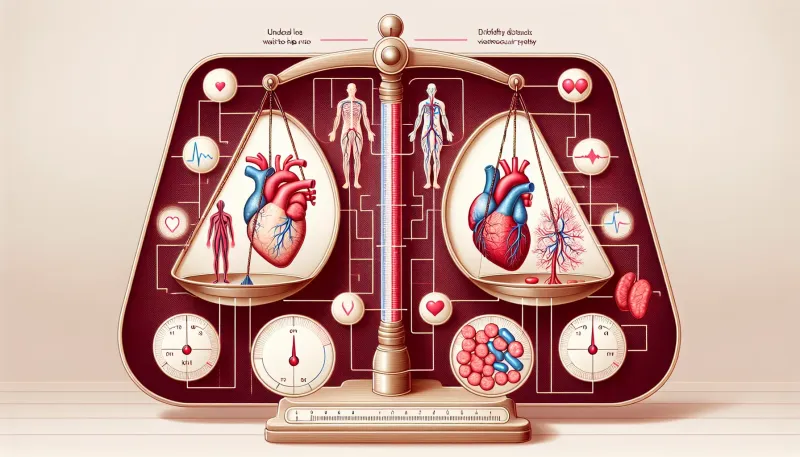Understanding the Link Between Waist-to-Hip Ratio and Cardiovascular Risk

Explore the connection between waist-to-hip ratio and cardiovascular risk. Learn why this metric is crucial for heart health and how to manage your risk effectively.
The relationship between body measurement metrics and health outcomes has been a topic of considerable interest within the medical and scientific communities. One such metric, the waist-to-hip ratio (WHR), has gained significant attention for its purported link to cardiovascular risk. This article delves into the nuances of WHR, exploring its connection to cardiovascular health and offering practical insights on how to manage and mitigate associated risks.
What is Waist-to-Hip Ratio?
Waist-to-hip ratio is a simple measurement that compares the circumference of the waist to that of the hips. It is calculated by dividing the waist measurement by the hip measurement. For example, if a person's waist is 30 inches and their hips are 40 inches, their WHR would be 0.75. WHR is considered an indicator of fat distribution in the body.
Why is WHR Important?
WHR is a critical metric because it provides deeper insight into the type and location of body fat, which can be more telling of health risks than body mass index (BMI) alone. Unlike BMI, which doesn't distinguish between muscle and fat and their distribution, WHR specifically helps gauge central obesity—the accumulation of fat around the abdomen. Central obesity is closely linked to an increased risk of cardiovascular diseases.
The Connection Between WHR and Cardiovascular Risk
Numerous studies have established a strong correlation between high WHR and several cardiovascular conditions, including heart attack, stroke, and hypertension. Here is why WHR is a crucial factor in cardiovascular risk:
1. Abdominal Fat and Cardiovascular Disease
Visceral fat, which accumulates around the abdominal area, poses greater health risks than subcutaneous fat found under the skin. Visceral fat is metabolically active and can lead to adverse metabolic effects such as insulin resistance, inflammation, and dyslipidemia—all of which are precursors to cardiovascular diseases.
2. Insulin Resistance
Higher WHR is often associated with insulin resistance, a condition where the body's cells become less responsive to insulin. Insulin resistance can lead to type 2 diabetes, which further increases the risk of developing cardiovascular conditions.
3. Blood Pressure and Lipid Imbalance
Elevated WHR often correlates with increased blood pressure and unfavorable lipid levels, including higher levels of low-density lipoprotein (LDL) cholesterol and triglycerides. These changes can contribute to the development of atherosclerosis—a condition characterized by the narrowing and hardening of the arteries due to plaque buildup.
Measuring and Monitoring WHR
How to Measure WHR
Accurately measuring WHR is a straightforward process:
- Measure the Waist: Place a measuring tape around the narrowest part of your waist, usually just above the belly button. Ensure the tape is level and not too tight.
- Measure the Hips: Place the measuring tape around the widest part of your hips and buttocks.
- Calculate WHR: Divide the waist measurement by the hip measurement.
Healthy WHR Ranges
The World Health Organization (WHO) provides guidelines for healthy WHR ranges:
- For men: A WHR below 0.90 is considered low risk, 0.90 to 0.99 is moderate risk, and 1.0 or above is high risk.
- For women: A WHR below 0.80 is considered low risk, 0.80 to 0.85 is moderate risk, and 0.86 or above is high risk.
Steps to Manage WHR and Reduce Cardiovascular Risk
Maintaining a healthy WHR can significantly mitigate cardiovascular risk. Here are some practical steps to help you achieve and maintain a healthy WHR:
1. Balanced Diet
A diet rich in fruits, vegetables, lean proteins, and whole grains can help you maintain a healthy weight and reduce abdominal fat. Limiting sugary beverages, processed foods, and trans fats is crucial for controlling visceral fat accumulation.
2. Regular Physical Activity
Engaging in regular aerobic exercises, such as walking, running, or swimming, can effectively reduce visceral fat. Strength training exercises also contribute to overall muscle mass and help in fat burning.
3. Stress Management
Chronic stress can lead to hormonal imbalances that foster fat accumulation in the abdominal area. Practices such as mindfulness, meditation, and yoga can help manage stress levels.
4. Adequate Sleep
Poor sleep patterns are linked to weight gain and increased fat storage, particularly in the abdominal area. Aim for 7-9 hours of quality sleep per night.
5. Regular Monitoring
Regularly measuring your WHR helps you stay informed about your health status and make timely interventions if necessary. Annual health check-ups can provide comprehensive insights into your cardiovascular health.
Conclusion
Understanding the link between waist-to-hip ratio and cardiovascular risk is essential for proactive health management. By paying attention to WHR and adopting a balanced lifestyle that includes a healthy diet, regular exercise, stress management, and proper sleep, you can significantly reduce your risk of cardiovascular diseases. Regular monitoring and early interventions are keys to maintaining heart health and overall well-being.



























